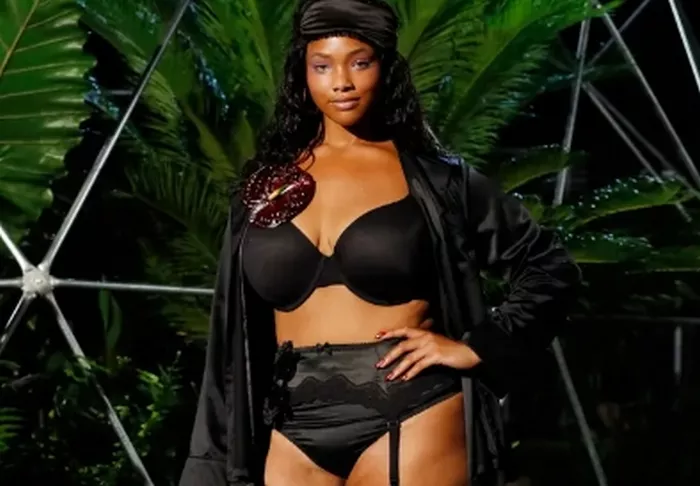In 2020, Dutch model Jill Kortleve was celebrated for making waves in the fashion world, walking the runways of some of couture’s most iconic designers. She was an advocate for inclusivity, emphasizing that being the right fit for a brand wasn’t about size. At that time, Kortleve, who wore an AU 10-12, became one of the first “plus-size” models for major fashion houses like Valentino, Versace, and Fendi, marking a significant step away from the industry’s traditional sample size.
However, just five years later, the progress made towards inclusivity appears to be faltering. During the recent Autumn/Winter 2025 shows, less than 1 percent of models were plus-sized, signaling a troubling trend back toward a focus on ultra-thin figures. According to the latest Vogue Business size inclusivity report, only 0.3 percent of the 8,703 looks presented at 198 shows across four cities were from plus-sized models, a significant drop from previous seasons.
Moreover, the percentage of mid-sized models represented on the runway has also declined, from 4.3 percent last season to just 2 percent. This is in stark contrast to the average size of an Australian woman, who wears a size 14-16.
Glamour magazine’s analysis further highlights the diminishing inclusivity, noting that only 26 plus-sized models were featured during London Fashion Week for the AW25 season. London remains the most inclusive of the “big four” fashion weeks—London, New York, Paris, and Milan—yet even here, there has been a noticeable reduction in plus-sized representation. Milan, in particular, stood out for having no plus-sized models at all during its AW25 shows.
The decline in inclusivity is also evident in the industry’s treatment of plus-sized models. Just three seasons ago, London reported showcasing 85 plus-sized models, and in the same year, Paloma Elsesser, a plus-sized model, was awarded Model of the Year by the British Fashion Council.
Australian model and content creator Shauna Ryan reflects on the early days of Rihanna’s Savage X Fenty shows, which made waves for their diverse, body-positive cast. “It was powerful seeing people who looked like me,” she shares. However, the industry’s current trajectory is a stark contrast, as Ryan observes the increasing lack of representation in the fashion world. Ahead of Australian Fashion Week, she found that only a handful of designers produced clothing for sizes 20 and above.
Ryan believes that fashion trends continue to send a damaging message by prioritizing smaller bodies and marginalizing those who don’t fit within this narrow mold. This exclusion extends beyond the runway, she points out, with many brands eager to engage with plus-sized influencers but failing to provide clothing in larger sizes.
Fellow content creator and curve model Annika Neilsen raises similar concerns, noting how her friend was made the face of a major Australian fashion week but walked on very few physical runways. This exclusion of plus-sized models raises questions about who within the industry is making these decisions and why.
The fashion industry’s increasing reliance on social media platforms like TikTok has amplified these issues. While trends are now shaped by influencers and user-generated content, negative body image and harmful content continue to thrive online. One recent TikTok trend, which allowed users to view themselves through an AI filter to simulate being overweight, has drawn criticism for its cruel intent.
The use of AI filters, combined with mainstream brands’ portrayals of body diversity, has made some question how fashion is evolving in the digital age. Vogue’s recent homage to Hairspray featured model Gigi Hadid in a plus-size role, yet it lacked any plus-sized actors, leaving many feeling that such portrayals were nothing more than a superficial gesture.
Psychologist Sarah Cox from the Butterfly Foundation explains that social media is exacerbating body dissatisfaction, with over 4.1 million Australians affected by it. The pressure to conform to certain body standards is heightened by trends like Ozempic, a weight loss drug that critics argue has fueled the resurgence of ultra-thin ideals.
Critics like Hillary Taymour, founder of the label Collina Strada, blame drugs like Ozempic for fostering a “skinnier and skinnier” fashion industry. Shauna Ryan echoes these concerns, likening the use of weight loss drugs to the resurgence of harmful fad diets from the ’90s and early 2000s.
The Butterfly Foundation has also noted a rise in appearance-based discrimination, with more than 3.1 million Australians experiencing weight-based bias in the past year alone. This trend highlights the ongoing struggles faced by those who don’t fit the industry’s ideal body standards.
For Shauna, the current state of fashion is disheartening. “It feels like the boat is sinking,” she says, urging others—particularly those in straight-sized bodies—to speak up and engage in the conversation. Annika agrees, calling for change at the top of the industry. She stresses that if the industry truly wants inclusivity, it must start with diverse voices shaping decisions from the very beginning.
As the fashion world continues to grapple with these issues, one thing is clear: to achieve true inclusivity, the industry must go beyond token gestures and make real, lasting changes to its leadership and design practices.
Related Topics
- Giambattista Valli Receives Industry Impact Award at Barcelona Bridal Fashion Week
- Roaring Fashions Expands to Full Retail Storefront in East Greenwich
- Fendi Baguette Reimagined for Men with Bold New Update

